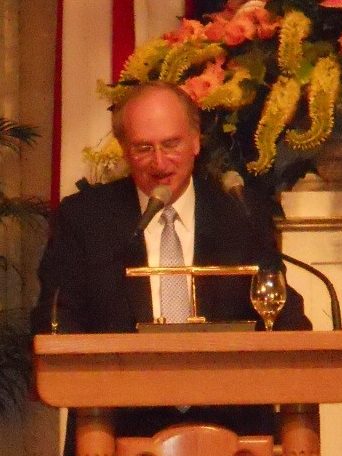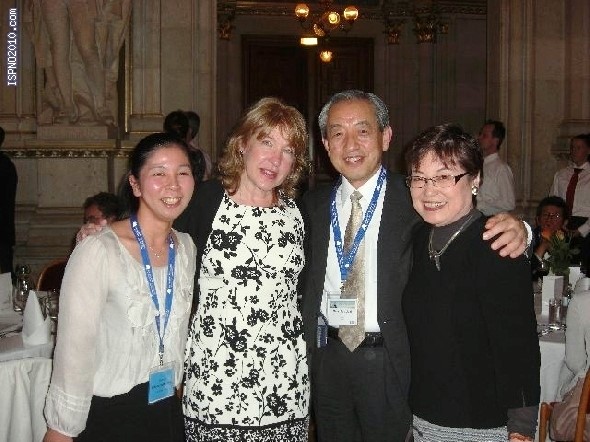
The Childhood Brain Tumor Foundation was delighted to be a silver sponsor of the ISPNO, held from June 20 through June 23, 2010, in Vienna, Austria. The ISPNO is held every two years alternating in and out of the United States. This important meeting brings together basic scientists, translational researcher, clinicians, and other medical professionals to share new developments, research initiatives, outcomes from clinical trials, progress in research initiatives, and late effects.

The Co-chairs for the 14th ISPNO were Irene Slavc, M.D. and Thomas Czech, M.D. They warmly welcomed the attendees and Functional Systems of the Brain. This article includes selective topics from the conference.
Keynote speaker, Robert P. Butler, Ph.D. presented information concerning effects of brain irradiation and methotrexate and neuropsychological function in children. Some of the effects include: decline in intelligence, attention and concentration disturbances, reduced processing speed due to treatment demylenating the brain, memory problems, visual/spatial deficits, visual/motor integration problems, difficulty with arithmetic, and socialization deficits. Infants usually have more global neuro-cognitive deficits. The standard of care includes an educational 504 Plan, Individualized Educational Plan, speech/language therapy services, occupational therapy (for non-dominant functions), special classroom, and medication. The new standards of brief /focused outpatient rehabilitative educational intervention, are important, but have been pushed out by insurance companies. He encouraged that children need to be taught to do their own personal best, prepare for activities, and how to be their own friend. Cognitive remediation programs are important for children with effects from tumor and/or treatment.
Plenary and Concurrent Sessions
Medulloblastoma/CNS-PNET – Biology: Chairs: Richard Gilbertson, Marcel Kool, and Christine Haberler
Integrative genomic analysis of medulloblastoma identifies a molecular subgroup that drives poor clinical outcome, Y. Cho, et al., Boston, MA;
Medulloblastoma (MB), a tumor of cerebellum or posterior fossa, is the most common malignant brain tumor in children. Medulloblastoma has a complex heterogeneity and multiple molecular pathways. Study results identified six molecular subgroups that were distinct within MB. DNA copy number, micro RNA (miRNA) profiles, and outcomes were studied determining that effective therapeutic strategies need to be explored.
Chromosome 17 and pediatric medulloblastoma, C. Haberler, et al., Vienna, Austria;
The most common genetic aberration in medulloblastoma is an alteration of chromosome 17 and they have found that chromosome 17q is detectable in 40-60% of all tumors. Study results indicate that MB with isochromosome 17q is a subgroup of medulloblastoma. Yet, isochromosome 17q might be only a surrogate marker, whereas other genetic events or a different cell or origin might represent the genetic background. [Neuro-Oncology, Volume 12, Issue 6, June 2010, ii4]
Medulloblastoma/CNS-PNET – Clinical: Chairs: Roger J. Packer, Stefan Rutowski, and Tom Merchant
Prognostic features of childhood medulloblastoma by magnetic resonance imaging, K. Yeom, et al., Stanford, CA, US; There are two features on MRI scans that indicate tumor aggressiveness; one is the presences of honeycomb enhancement patterns and the other T2 heterogeneity. In such cases, it may be warranted to consider treatments that correlate with more aggressive tumor.
Diffuse Intrinsic Pontine Glioma: Chairs: Stewart Goldman, Mark Souweidane
Prospective collection of tissue samples obtained at autopsy in children with diffuse intrinsic pontine glioma, J. N. Baker, et al., Memphis, TN, US; Currently there are no effective therapies for DIPG a devastating pediatric brain tumor malignancy. The study involved tissue acquisition through biopsy and autopsy. The median stupso acquisition time was 7.5 hours. The goal was to assess feasibility of such tissue use for genome-wide molecular analyses in children with DIPG. In addition, normal tissue was collected at autopsy and the integrity of DNA and RNA was evaluated and showed minimal degradation. These results indicated viability and suitability of postmortem specimen for molecular analyses. Families Assessments indicated that parents did not regret participating in the study.
Molecular profiling of pediatric diffuse intrinsic pontine gliomas at diagnosis identifies two biologically distinct entities, S. Puget, Paris, et al., France; DIPG is problematic due to the lack of tissue sample at diagnosis. Through this study they identified two molecular subgroups of DIPG characterized by chromosomal abnormalities. The two identified subtypes indicates that pediatric gliomas are different from adult gliomas and provides potential therapeutic targets.
Predicting outcome of children with DIPG using multiparametric imaging, S. J. Hipp, et al., Bethesda, MD, US; Data showed that increased perfusion at either the initial imitating or at any time point predicts shorter survival. In combination with increasing enhancement it can be useful to predict survival. Although proton spectroscopy may describe metabolic features of tumors, it does not predict survival in patients with DIPG when combined in the study data set. [Neuro-Oncology, Volume 12, Issue 6, June 2010, ii9]
High grade glioma: Chairs: Ken Cohen, Ian Pollack
Clinical and molecular characteristics of congenital glioblastoma multiforme (cGBM), M.E. Macy, et al., Aurora, IN, US; Congenital glioblastoma multiforme is highly aggressive and requires extensive chemotherapy for cure. This study included the characterization of molecular biology of congenital cGBM compared to other pediatric and adult gliomas. Gene expression clustering analysis showed that cGBMs forme a distinct subgroup within the high grade gliomas (HGGs) indicating unique molecular characteristic of cGBMs. The altered expression of genes in development may imply that the aggressive course of these tumors is attenuated by recapitulation of normal development pathways. [Neuro-Oncology, Volume 12, Issue 6, June 2010, ii11]
Neuropsychology: Chairs: David Ashley, Robert Butler
Assessment of attention in children with brain tumors: What should we look at? L. Weller, et al., Vienna, Austria; Evidence has shown that children with brain tumors often have attention performance deficiencies. The study aim was to assess performance with a detailed approach, looking at alertness, processing speed, focused attention, sustained attention, distraction, and divided attention. In conclusion, the study results indicate that children with brain tumors have altered attention, alertness, and distraction versus the control group. However alert attention was not affected in these children. Detailed assessment is important to ensure these children have appropriate intervention.
Multidisciplinary approach to the patient and family: Chairs: Christine Chordas, Deborah Lafond, and Andrea Prinz
Employment status and social cognition in adults following pediatric brain tumor treatment, T. T. Vlagsma, et al., Groningen, Netherlands; Children who undergo treatment from pediatric brain tumors often have permanent cognitive deficits that can impact employment potential. In this study they explored employment and social implications. Comparisons were made in astrocytoma patients who had surgical resection versus medulloblastoma patients who were treated with surgical resection, whole brain radiation, and chemotherapy. Compared with the control group, although 38% of medulloblastoma survivors and 60% of the astrocytoma group had regular employment, they found that the combined patient group had significantly lower scores on general cognitive and social cognition tests. As such, poor cognition and may have contributed to loss of employment. In conclusion, more support is needed for pediatric brain tumor patients as they enter the workforce to improve their education and chances for gainful employment.
Integrating a Late Effects Clinic Into a Neuro-Oncology Program, D. Lafond, et al. CNMC, Washington, DC, US; Comprehensive care post care follow-up is important for survivors. Pediatric brain tumor survivors are prone to multiple late effects, such as, endocrine, musculoskeletal, neurologic, pulmonary, sensory, and integumentary issues. Included in these issues are potential educational, psychosocial, financial, and legal obstacles. Ms. Lafond stressed the importance of providing solid care that will enable survivors to feel empowered to advocate for themselves and find successful paths.
Low grade glioma –Clinical: Chairs: Mark Kieran, Astrid Gnekow, Shlomo Constantini
Phase I/II Study of Tarceva/Rapamycin for Recurrent Pediatric Low Grade Glioma, R. J. Packer, et al. CNMC, Washington, DC, USA; The study was a prospective, international, multi-center study for recurrent pediatric low-grade. In conclusion, the Phase I/II study showed that Tarceva/Rapamycin regimen is well-tolerated and has demonstrated efficacy in children with recurrent low-grade glioma, especially in patients with neurofibromatosis.
Low grade glioma –Biology: Chairs: Stefan Phister, Jacques Grill
Tumor Vasculature and Angiogenic Profile of Pediatric Pilocytic Astocytoma (PA); Is it much different from glioblastoma?, M. Sie, et al., Groningen, Netherlands; Although the 5-year survival rate of PA is is 90%, outcomes is not always favorable. In this study the aim was to study tumor vasculature. In conclusion, they found that despite PA having a different vessel architecture compared with GBM, a critical overlap in vessel immaturity/instability and angiogenic profile was seen between both tumors. Finding suggest encouraging possibilities for targeting angiogenesis (for instance with anti-VEGF) as a therapeutic strategy in PA patients. [Neuro-Oncology, Volume 12, Issue 6, June 2010, ii24]
Ependymoma: Chairs: Didier Frappaz, Michael Taylor, Amar Gajjar
Proton Therapy for Childhood CNS Ependymoma: Clinical Outcomes in a Cohort of 49 Patients, S. M. Macdonald, Boston, US; Proton radiation therapy offers highly conformal radiation while sparing normal tissues. In conclusion, the study showed that nongross total resection correlated with inferior outcome. Due to the proximity to crucial structures and early age of diagnosis proton therapy is an ideal method of radiotherapy for children with ependymoma. [Neuro-Oncology, Volume 12, Issue 6, June 2010, ii27]

Germ cell tumor: Chairs: Masao Matsutani, Jeffrey Allen
Can Serum and/or Lumbar CSF BHCG be used to Diagnose a CNS Germinoma? et al., J. C. Allen, NY, US;
Tumor location and small tissue sample hinder histologic confirmation of CNS germ cell tumors. In this study they found that until a more sensitive and specific serum and or CSF marker is discovered for pure germinoma, histologic confirmation is warranted.
Atypical teroid rhabdoid tumor: Chairs: Maria Luisa Garre, Susan Chi
Inhibition of Aurora Kinase A radiosensitizes AT/RT cells and increases cell death, T. L. Tello, et al., Denver, US. AT/RT are malignant and aggressive central nervous system tumors. The goal of the study was to identify targets using microarray- based analysis of Aurora Kinase. In conclusion, treatment of AT/RT cells with low dose radiation and Aurora Kinase inhibitor can synergistically 1) decrease tumor cell survival; 2) decrease cell proliferation and; 3) increase cell death. Aurora Kinase A may be a promising target for treating AT/RT.
June 23, 2010: Parent, Survivor & Sibling Meeting
The Childhood Brain Tumor Foundation was pleased to provide input for the planning of the Family Education Day. The session was attended by over 50 people. Dr. Irene Slavc and Anita Kienesgerger opened the meeting and welcomed the attendees. Translation was provided in English and German.
Following Julia’s enlightening speech, a panel of experts shared vital information. Roger J. Packer, MD, Children’s National Medical Center, Washington, DC presented, Childhood Brain Tumors, Opportunities for Biologic-Based Therapies. Dr. Packer provided an excellent overview of tumor locations and spoke of variables based on tumor location. Ten to 30% of suprasellar tumors are craniopharyngioma, astrocytoma, or germinoma, located in the space above the brain stem under the pituitary. Fifty percent of tumors are found in the posterior fossa and are medulloblastoma, cerebellar astrocytoma, ependymoma, brain stem glioma, and AT/RT, located behind the pons. Pineal tumors comprise approximately 5-10% of pediatric brain tumors, germinomas, NGGCT, pineoblastoma, and astrocytoma, located below the corpus callosum. Twenty to thirty percent of cortical tumors are astrocytomas, ependymoma, neuroglial tumors, PNET, about two thirds above the corpus callosum. Dr. Packer broke down brain stem gliomas as 15% low grade, 20% focal, and 8% as diffuse tumors. The survival rate for diffuse pontine gliomas is less then 10%. Tumor, treatment types including surgery, radiation, chemotherapy, and combination treatments play a role in long term issues. Packer suggested that decent second opinion includes review of records and nuances about family. Drugs are being developed to reverse learning problems. Dr. Packer stated that the dream of the future is to tailor treatment by utilizing molecular genetics and developing more effective and specific drugs.
F.H. Saran, Royal Marsden, Department of Radiation Oncology spoke about Radiation Therapy- Novel radiation techniques for pediatric brain tumors. She described proton therapy as a special energy, targeting a defined area and being more focused. Conventional radiation cannot bend like protons. Tomotherapy rotates around the patient, is conformal and defined.
Stephen Michael Shalet, MD, United Kingdom, covered Endocrine System and Pediatric Brain Tumors. Questions arose about growth hormone replacement and risk brain tumor recurrence. Studies have been done and there has been no evidence that growth hormone replacement will encourage tumor progression or recurrence. He further commented that the timing of growth hormone replacement at one year versus two years is an individual decision.
Shawna L. Palmer, St Judes, provided a comprehensive overview of psychosocial issues concerns for brain tumor survivors. Post treatment issues of concern include white matter damage post treatment, younger age of treatment, and dose-tumor response, and processing speed. Dr. Palmer provided tips about how to deal with school issues. She indicated that studies comparing neurocognitive outcome to imaging studies is of interest.

CBTF-MD president, Jeanne Young presented during the session entitled, Meet the Experts, Parents as Experts. The session touched on some of the issues that occur post treatment. No stranger to brain tumors, a multi-generational issue for Jeanne, she provided insights based on her personal experience and included some insights shared from parents she has worked with. Jeanne stressed to parents the importance of encouraging their children to be responsible about follow-up care as needed with the appropriate experts based on their situation. In addition, she shared a few stories to highlight the importance of encouraging the survivor to try to achieve goals and to develop a healthy social life. Jeanne’s son is a long-term survivor of diffuse optic nerve glioma, is legally blind, and was expected to relapse a couple of years post treatment. He is currently taking classes at the community college and has enjoyed many years of stability.
The Childhood Brain Tumor Foundation is deeply appreciative of the researchers and medical professionals who work tirelessly to find cures and improve the quality of life of children afflicted with brain tumors. We thank Drs. Irene Slavc and Thomas Czech, 2010 ISPNO Chairs and Dr. Roger Packer, Vice Chair for putting together such an informative conference that can only help to further the progress that all parents hope for. With the combined efforts of the brain tumor community the “dream of cures. will become a reality!”
This article only covers some highlights from the ISPNO conference. We regret that all topics could not be covered.
Written by Jeanne Young with excerpts from the Journal of Neuro-Oncology.
Reviewed by Javad Nazarian, Children’s National Medical Center.
